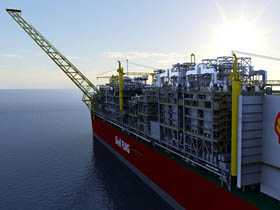It’s ironic that considering the gargantuan proportions of the Prelude floating liquefied natural gas (FLNG)project currently under construction, that it’s actually its outstanding representation of miniaturization that makes it truly unique. At over half a kilometer in length and displacing more water than six aircraft carriers, Prelude would stand higher than the Petronas Towers in Kuala Lumpar if you stood her on her end. Yet the footprint of the vessel is just a fraction of that of a land-based gas plant, it doesn’t use valuable land for pipelines and every year it will produce more LNG than Hong Kong uses annually.
Intrigued? We were too, which is why Stainless Steel World interviewed Anthony Pearson of SBM Offshore and Andrew Barnes Shell Global Solutions. We wanted to know more about the materials used in this mammoth project, and the facts revealed did not disappoint.
Fascinating facts!
600 engineers worked on the facility’s design options.
4 soccer fields, laid end to end, would be shorter than the facility’s deck.
175 Olympic-sized swimming pools could hold the same amount of liquid as the facility’s storage tanks.
6,700 horsepower thrusters will be used to position the facility.
50 million liters of cold water will be drawn from the ocean every hour to help cool the natural gas.
It will displace 600,000 metric tons of water, the equivalent of six aircraft carriers.
93 meters is the height of the geostationary turret that runs through the facility, secured to the seabed.
With a lifespan of at least fifty years, Prelude is described by Shell Oil as an environmentally friendlier alternative to an onshore LNG refinery. After all, it can be redeployed to new fields and uses 50% less materials and has 95% less land and seabed disturbance than land-based refineries.
FLNG is a revolutionary technology that will allow Shell to access offshore gas fields that would otherwise be too costly or difficult to develop; in this case in the Browse Basin, 475 km northeast of Broome, Australia. Cooled to -162° Celsius (-260°F), the natural gas shrinks to 1/600 of its volume when it is turned into LNG. Prelude will remain on location off Australia for 20-25 years to develop gas fields in the Browse Basin.
The project is requiring a re-think of how super-sized parts are forged. For example one of the solid duplex Gas Production Swivel Outer Parts measured 2990mm outside diameter and had a forged weight of 17200 kg! New technologies such as thermally sprayed aluminum coating on duplex are also being deployed to extend the life of parts.
Read the full article about this amazing project in the Stainless Steel World files.


